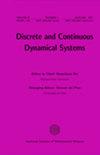具有Sobolev光滑快速驱动势的线性波动方程的可约性
IF 1.1
3区 数学
Q1 MATHEMATICS
引用次数: 1
摘要
证明了一维环面上具有时间准周期驱动的线性波动方程的可约性。假设驱动是快速振荡的,但不一定是小尺寸的。如果外部频率矢量足够大,且选自一个大测度的康托集合,则将原始方程共轭为一个与时间无关的块对角线方程。在本文中,我们将先前的工作\cite{FM19}推广到更一般的假设:我们用Sobolev正则替换时间上的解析正则;Schrödinger运算符中的势函数是一个非平凡的平滑函数,而不是常数函数。实现该结果的关键工具是Schrödinger算子的每个特征函数靠近指数子空间的局部化特性,并且多项式衰减远离后者。本文章由计算机程序翻译,如有差异,请以英文原文为准。
Reducibility for a linear wave equation with Sobolev smooth fast-driven potential
We prove a reducibility result for a linear wave equation with a time quasi-periodic driving on the one dimensional torus. The driving is assumed to be fast oscillating, but not necessarily of small size. Provided that the external frequency vector is sufficiently large and chosen from a Cantor set of large measure, the original equation is conjugated to a time-independent, block-diagonal one. With the present paper we extend the previous work \cite{FM19} to more general assumptions: we replace the analytic regularity in time with Sobolev one; the potential in the Schr\"odinger operator is a non-trivial smooth function instead of the constant one. The key tool to achieve the result is a localization property of each eigenfunction of the Schr\"odinger operator close to a subspace of exponentials, with a polynomial decay away from the latter.
求助全文
通过发布文献求助,成功后即可免费获取论文全文。
去求助
来源期刊
CiteScore
2.50
自引率
0.00%
发文量
175
审稿时长
6 months
期刊介绍:
DCDS, series A includes peer-reviewed original papers and invited expository papers on the theory and methods of analysis, differential equations and dynamical systems. This journal is committed to recording important new results in its field and maintains the highest standards of innovation and quality. To be published in this journal, an original paper must be correct, new, nontrivial and of interest to a substantial number of readers.

 求助内容:
求助内容: 应助结果提醒方式:
应助结果提醒方式:


